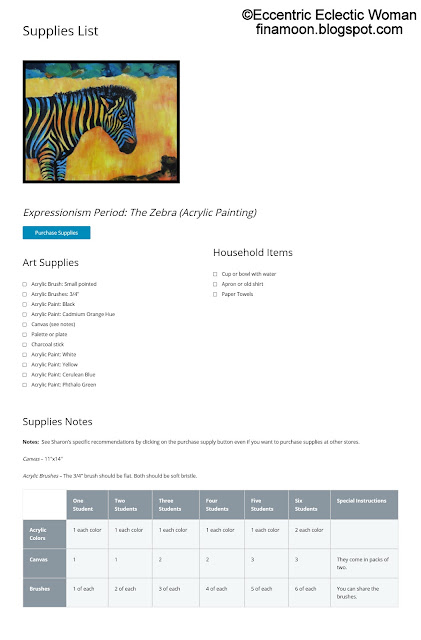Disclaimer: I received this complimentary product through the Homeschool Review Crew in exchange for my honest review. I was not required to write a positive review nor was I compensated in any other way.
My family had the privilege of trying the Art History Program from Creating A Masterpiece for this review to use in conjunction with our own curriculum at home. This is a Homeschool Review Crew Review. All opinions expressed are my own or those of my family.
Creating A Masterpiece is founded by Sharon Hofer. Sharon traveled all over the world to study art under some of the finest artists of our time at world-renowned art institutes and studios for the past three decades. She learned that anyone can create a masterpiece and started this online art instruction that teaches aspiring artists step-by-step at their own pace to create beautiful art.
 |
| Sharon Hofer of Creating a Masterpiece. |
The Art History Program is part of the Creating A Masterpiece line of award-winning art curriculum. These lessons will have you learning the same techniques as the art masters through video lessons taught by Sharon Hofer. This program is a great addition to art history studies. Instead of just reading about the great masters of art, you can recreate their masterpieces too! Your student will learn how to recognize and create period specific art styles and master art skills needed to make masterpieces. They will also learn how to use different art media, for example: sculpture, colored marker, fresco, printmaking, acrylics, mosaic, egg tempera, glass etching, etc. The program comes with art supply lists for each project that are set up so that you can purchase all that is needed on Dick Blick, a wonderful art supplier.
This program features:
- Styles of Art in History: In these projects students learn how to create fine art that mimic art styles from different periods of the past. For example: Romanticism, Realism, Cubism, etc. Recommended for ages 5 and up.
- Historically Themed Projects: These projects can add art to your study of history. For example: a ship in a lagoon representing the Spanish Exploration or a Native American Chief representing life in Early America. Recommended for ages 6 and up.
- Exploring the Art of Yesterday: In this project the student will learn to recreate an art piece from Ivan Aivazovsky. Recommended for ages 13 and up. This is a more difficult project.
- Capstone Project. These projects are meant to teach the student how to recreate historic masterpieces. These are taught at a masterpiece level and should only be attempted by those who meet Sharon's criteria in the project description.
How We Used This and Our Thoughts:
We were given access to all the art projects from Creating a Masterpiece until December 31, 2021. There were many different art lessons we could chose from, but we focused on the art history sections in Creating A Masterpiece as this is what we were supposed to review. The art was accessed by logging in and clicking STUDIO in the top right corner. Then we scrolled down to the bottom sections because that is where the Art History Programs were located.
We chose three different art pieces to do for this review from The Art History Program of Creating a Masterpiece. The first was the Expressionism Period: The Zebra (Acrylic Painting) from the Styles of Art in History section. This project I will go into more detail than the others and show pictures. We also did the Ancient Egypt: Egyptian Nomads and the Revolutionary War: The Cannon (Ink) from the Historically Themed Projects section.
I wish each art project would have the level clearly stated according to difficulty. Most do in the project description, but some do not say and so this made it harder to choose the project. The ones that do have this label go from 1-5 in difficulty. All three of the projects we chose had the level in the project description.
 |
| The Zebra art supply list. |
Each project comes with its own art supply list and purchase list. Just click the "View Supply List" button to see the art supply list. This list shows you what art supplies you will need for the individual project and helps you determine quantity depending upon how many students you have doing the same project. There is also a purchase list of the same supplies provided by Creating A Masterpiece in Dick Blick. You can view this list by clicking the "Purchase Supplies" button. If you already have the art supply at home or need more of the item you can easily adjust the quantity of each item and then add the items you do need to your cart to purchase. You can buy supplies from the provided Dick Blick list or buy them elsewhere if you find them cheaper or want to buy locally. I would also suggest watching the first or second video in each project so you know if you need to buy supplies or can use what you have at home. The art supplies listed are highly recommended as they are the best choice for getting the finest results for the art taught. We bought supplies for The Zebra and The Cannon, but had what we needed for the Egyptian Nomad picture at home.
 |
| The Zebra purchase supply list. |
 |
| The Zebra Blick art supplies. |
The first art piece I chose to do because it was a level 3 and I wanted to do some painting with acrylics. I chose The Zebra from the Styles of Art in History section. My daughter, Zari's favorite animal is a zebra, so I decided to surprise her with the art piece after I finished it. There are 5 lessons for this project and within each lesson there are two to three sections each in video format so the lessons are broken up and not too long and you can follow along better. The painting style I learned was from the Expressionism Period. I learned that in the Expressionism Period they used color to express emotion. I finished my zebra painting by signing my signature Fina🌙 in the corner. This project would be great for those learning more about the Expressionism Period.
 |
| How The Zebra project is laid out. |
The second art piece we did was the Ancient Egyptian Nomad scene from the Historically Themed Projects section. It is a level 1 art piece. We used our markers from home because in the video Sharon says not to go out and buy new markers. We also used regular paper because she said we could use that or marker paper, which we didn't have. We picked similar colors as what she chose in the color swatches. This project has one lesson with 5 video sections. We loved how the silhouette of the nomad riding on the camel took shape and the pyramids in the background became colorful with designs.
 |
| The Zebra progression. |
The third art project we did was The Cannon. This was a project from the Historically Themed Projects section and level 2 in difficulty. We learned a bit about the Revolutionary War by reading the description of the project. The Cannon is a single lesson project that is broken up into 9 sections. This project used ink in an interesting way, like watercolor. Before doing the project we purchased these supplies through Blick as well. The supplies included a Bristol paper pad, a red sharpie twin tip marker, a Tombow dual brush pen, a size 14 flat brush, and a size 0 round brush. We loved learning the technique to making the pen ink look like watercolor. We will be using this technique in other art projects later on.
 |
| My finished Zebra painting. |
The Creating A Masterpiece Art History Program was a lot of fun. We enjoyed the projects and lessons thoroughly and are excited to do more of the projects. Sharon Hofer is a great teacher and she explains everything well. These projects go very well with a history curriculum. We highly recommend this to anyone wanting to learn more about art and/or the process of making a masterpiece.
Follow Them on Social Media:
- Facebook: https://www.facebook.com/createamasterpiece
- YouTube: https://www.youtube.com/channel/UCyDU-6301Pwj_1Dez9YkumQ
- Hashtags: #hsreviews #fineartonline #CreatingaMasterpiece #ArtClassOnline #ArtCurriculum #ArtEssentials #DrawingCourses #ArtHistoryCurriculum
BUY IT
The Creating A Masterpiece Art History Program can be purchased in monthly or yearly subscriptions for $29.99/month or $299/year. Homeschool special rates are always available to those who contact them.
Read other homeschool curriculum reviews for Creating A Masterpiece Art History Program...



No comments:
Post a Comment